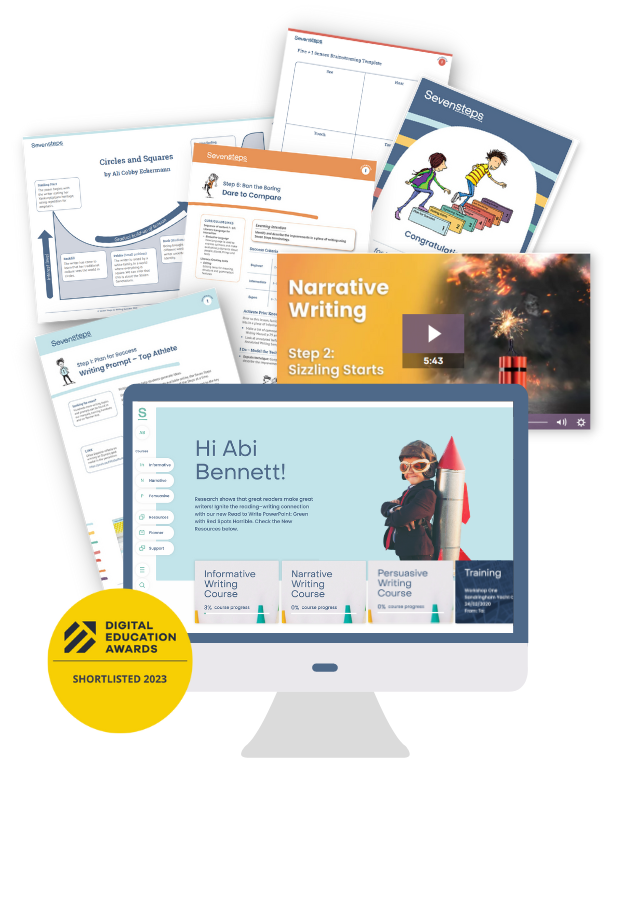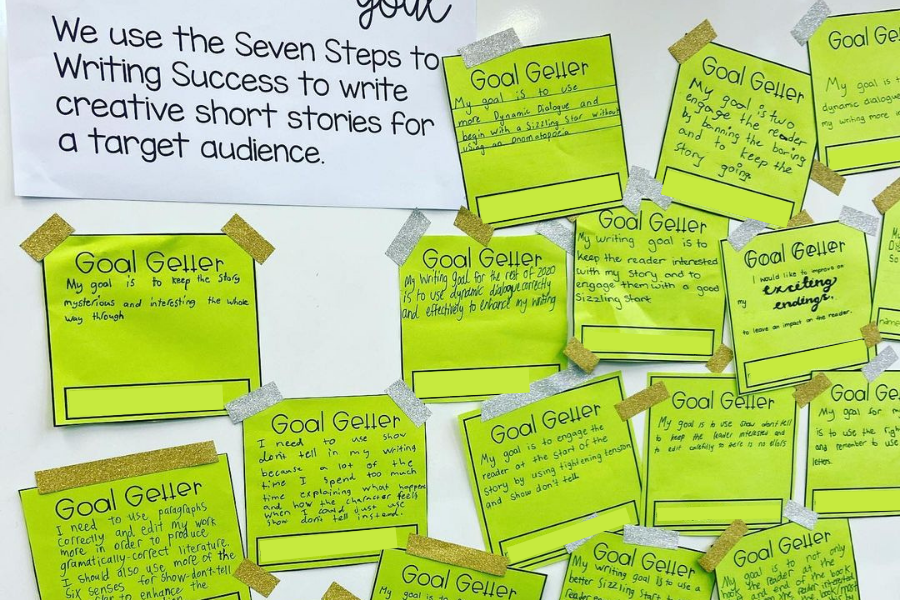No products in the cart.


Ideas from Teachers

Admin SEVEN STEPS
New year new writing goals! Starting the year or term with clear writing goals helps students to gain awareness of their learning, growth and achievements. This results in increased engagement and a willingness to progress! It’s a win-win!
Where to begin with goal setting
Before developing writing goals, we suggest pre-testing your students first. By identifying what they know and what they don’t, what they can demonstrate you’ll be able to uncover the common strengths and weaknesses that need to be addressed in your teaching.
To help you through the process of setting and achieving writing goals, we’ve gathered insights from some passionate and experienced Seven Steps teachers. We hope you find these ideas helpful in finding the perfect method for you and your students!

Creating a goal-getter culture
When I set writing goals I like to find a goal that is in line with the text type we are working on and I start by setting these for students when I mark a piece of their writing. I use coloured slips of paper for easy printing and sticking, either a series of common goals for the cohort or I write individual goals for students who require something a bit more specialised.
Goals can be based on the Seven Steps, for example:
- I can use a Sizzling Start to engage my reader.
- I can use Dynamic Dialogue to move the plot forward.
Or they can be based on language conventions.
- I can use a noun group to paint a visual picture.
- “New speaker, new line” for direct speech.
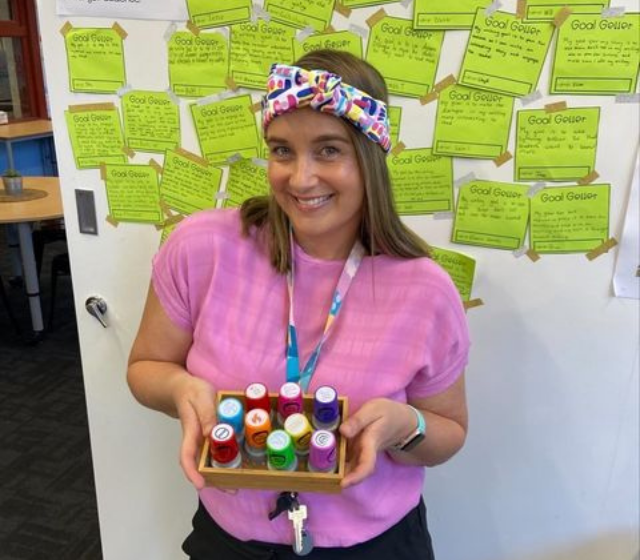
Rachael Craig @ourwonderfulclassroom
2022 Curriculum Lead, DfE
Kaurna Country, Adelaide, SA
Students have the goal slips stuck into their book and are encouraged to read and revisit the goal before they start writing. We often do this by reading our goals to a learning partner.
They need to reach their goal 3-5 times (age depending) before they can receive a new one.
I date and put a stamp or a sticker on their goal sheet to acknowledge success. When a writing goal is reached I write ‘goal getter’ and their goal achievement is communicated home. Students love reaching their goals, it gives them a sense of achievement and success.
Sometimes it becomes apparent, when marking, that a goal is too challenging and a new one needs to be set. Sometimes students need the same goal later on if they fall back into old habits – that’s ok! As long as everyone is working towards a goal that helps them to progress, then they will improve.
When a culture of goal setting is established, students will set their own and we display and celebrate as a class.


Progressing towards student-lead feedback
When it comes to setting writing goals for students it’s something I firstly model for students through conferences and co-constructing and deconstructing writing samples with students. We analyse pieces of writing and use the National Literacy Learning Progression as the basis for our writing goals.
We look for evidence in our writing and then try and find which “level” our writing is at. From here we then look for what we need to do to “up-level” our writing.
Usually, at the start of the year, it’s very teacher-led and as the year progresses it becomes a lot more student-directed through self and peer feedback as well as teacher feedback.

Mr Aaron Johnston @mr.j.learning.space
Assistant Principal & Stage 3
Darkinjung/Guringai Country | Central Coast, NSW
As students are working on their writing they are looking for proof that they have met their goal on at least 3 occasions over a week or fortnight cycle before a new goal is set. I’m continually taking notes as well for each student to help me if a student isn’t able to come up with a goal and I can support them by looking through my anecdotal notes.
During writing lessons, students are placed in groups based on their writing goals so I usually have 4-6 kids per goal and during the writing lessons I am conferencing and running explicit workshops on that goal with the groups.

Students self reflect and pick a main writing goal
To help students set goals for writing we look at a good modelled text on our interactive whiteboard based on the text type we are covering such as narrative.
We annotate and break down what is good about it such as punctuation, complex sentences, characterisation and the Seven Steps techniques. This becomes our success criteria for writing a good narrative and we dot point this on the whiteboard.
Then students go back to their desks and open up a ‘cold task’ of their writing where they recently wrote a narrative without much teacher support and guidance.
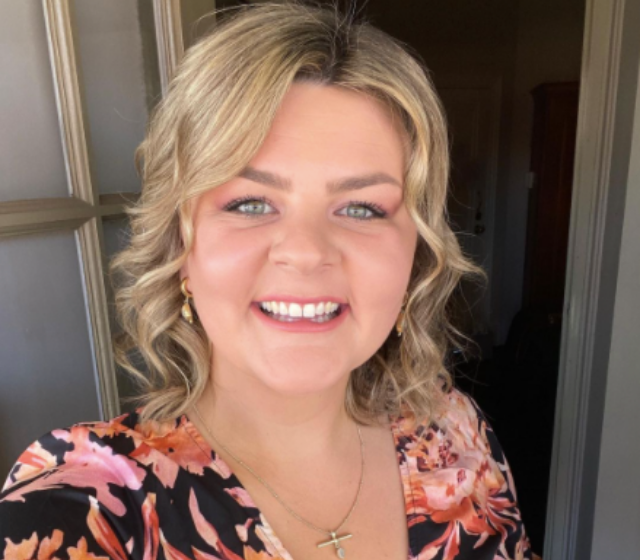
Miss Gabrielle Nichol @missnicholsclassroom
Level 3 Classroom Teacher
Whadjuk Country | Perth, WA
Students self-reflect and pick a main writing goal that they write down in their writing book. Some students pick two or three goals if they are highly capable learners. The goals are student-driven which motivates them to apply their learning and reach their target.
I saw students become more intrinsically motivated to reach their goals. Another outcome was seeing students demonstrate more perseverance and understanding about what they needed to work on which allowed them to experience more success.
Students were able to learn the routine and benefits of goal setting so once they achieved one goal, they felt proud and were able to restart the process. They became really engaged in their learning.

Sharing circles
In the younger years (where there’s less of a gap between ability and they’re not embarrassed to share things) occasionally I’d use feedback slips and give students an opportunity to read their feedback slip before their next writing session so it was at the forefront of their mind.
Sometimes we’d have sharing circles and every student would share their writing if they liked. Peers would give positive feedback and one thing to work on.
I’ve kept records of goals on a formative assessment page with a grid. I’d take notes as students are working and group them on a common writing goal, then run a guided writing session with those students. This can be text type-specific, or just for general writing skills.
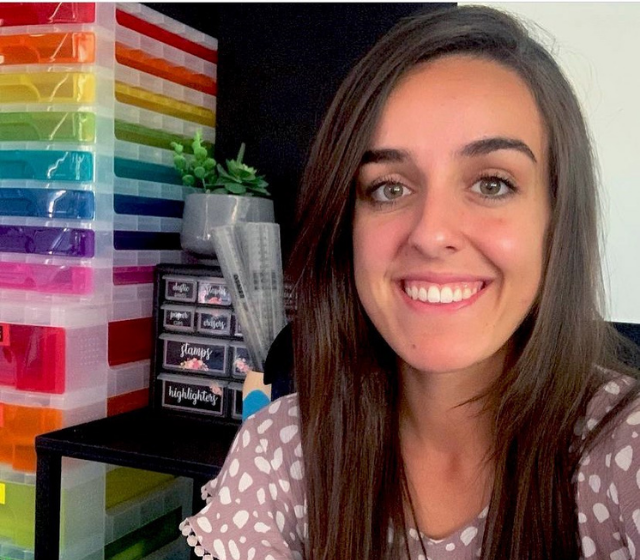
Miss Rhiannon Lee @creationsineducation
Teacher, lesson ideas & resource creator
NSW
Outcome
Many of my students would make quick progress with their goals as they had targeted instruction specific to an area of need, which allowed them to remediate their errors or improve their weaknesses. Small group, teacher guidance allowed them to clarify misconceptions or support them to improve their writing through explicit practice before applying this into their independent writing.

Pre-testing and assessment at the start of the year
With the disruptions and obstacles to teaching and learning over the past few years, it’s more important than ever to start by assessing (pre-testing) where students are at and tailor your writing lessons to meet their needs.
How to pre-test student writing to guide your teaching >>
Teacher Hub
Skyrocket engagement and writing results
- On-demand training
- Curriculum-aligned resources
- Time-saving planning and assessment tools
